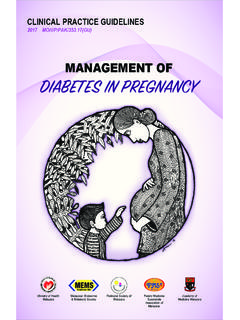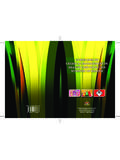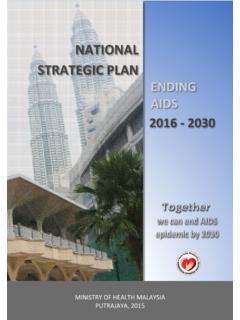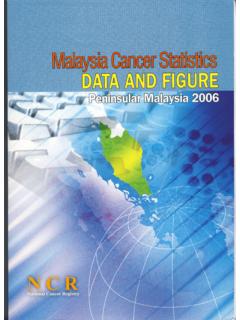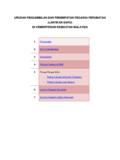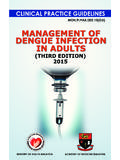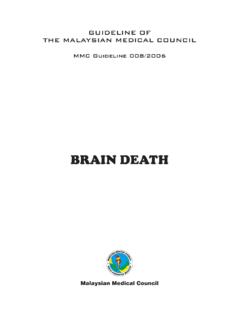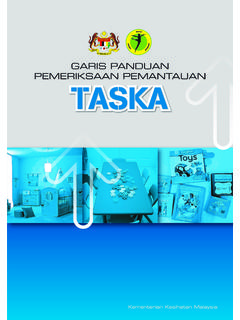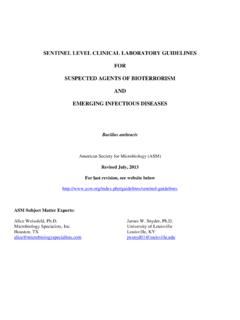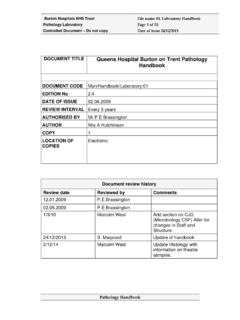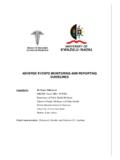Transcription of HAND FOOT AND MOUTH DISEASE (HFMD) GUIDELINES
1 HAND foot AND MOUTH DISEASE . ( hfmd ). GUIDELINES . EDITORIAL BOARD. ADVISORS: Dato' Dr. Hj. Ramlee bin Hj. Rahmat Director of DISEASE Control (2003 Dec 2006). Dato' Dr. Hasan Abdul Rahman Director of DISEASE Control (Dec 2006 until now). MEMBERS: Dr. Zainudin Abd Wahab Deputy Director of DISEASE Control (Surveillance). DISEASE Control Division, MOH. Dr. Abd. Rasid Kasri Deputy Director of DISEASE Control (Communicable DISEASE ). DISEASE Control Division, MOH. Dr. Rohani Jahis Principal Assistant Director (Surveillance). DISEASE Control Division, MOH. Dr. Izuna Mudla Mohamed Ghazali Assistant Director (Surveillance). DISEASE Control Division, MOH. 2. TABLE OF CONTENTS. 1. 4. 2. THE DISEASE .. 4. TRANSMISSION .. 4. CLINICAL FEATURES .. 4. MAGNITUDE OF THE DISEASE .. 6. 3. CLINICAL MANAGEMENT OF hfmd .
2 7. SYMPTOMATIC TREATMENT .. 7. HOSPITALISATION.. 7. Criteria for admission .. 7. Infection control .. 7. PATIENTS WITH NEUROLOGIC COMPLICATION .. 8. ADVICE GIVEN UPON PATIENT'S DISCHARGE .. 9. 4. SURVEILLANCE .. 10. OBJECTIVE OF SURVEILLANCE .. 10. CASE DEFINITION .. 10. Clinical case 10. Laboratory criteria .. 11. Case classification .. 11. TYPES OF SURVEILLANCE .. 11. Clinical 11. Laboratory surveillance .. 12. Flow of surveillance data .. 14. 5. MANAGEMENT OF SPORADIC CASES .. 16. OF SPORADIC CASE: .. 16. PUBLIC HEALTH MEASURES .. 16. 6. MANAGEMENT OF OUTBREAK .. 18. DEFINITIONS OF OUTBREAK .. 18. IDENTIFICATION OF OUTBREAKS .. 18. RISK FACTORS FOR OUTBREAKS .. 18. MANAGEMENT OF OUTBREAKS .. 18. DOCUMENTATION AND 20. 7. 216. 3. 1. INTRODUCTION. Hand foot and MOUTH DISEASE ( hfmd ) is typically a benign and common illness among children and infants characterized by rapidly ulcerating vesicles in the MOUTH and lesions, usually vesicular, on the hands and hfmd is an endemic DISEASE in Malaysia.
3 hfmd has become an important public health DISEASE due to its tendency to cause large outbreaks and deaths among children and infants. The purpose of the GUIDELINES is to help health personnels and health authorities, at any levels;. To update current knowledge about hfmd . To detect and control epidemic of hfmd as early as possible To strengthen the capacity for emergency response to epidemics of hfmd . To improve the outcome of hfmd cases through effective case management. 2. THE DISEASE . Hand foot and MOUTH DISEASE ( hfmd ) is caused by systemic infections with human enteroviruses. Human enteroviruses comprise one genus in the family Picornaviridae, which also contains the genera rhinovirus, cardiovirus, aphthovirus, hepatovirus and parechovirus. The members of the enterovirus genus that infect humans include the polioviruses, the Coxsackie virus groups A.
4 And B, the echoviruses and the enteroviruses Transmission Hand foot and MOUTH DISEASE ( hfmd ) is moderately contagious. Infection is spread from person to person by direct contact with nose and throat discharges, saliva, fluid from blisters, or the stool of infected persons. A person is most contagious during the first week of the illness. Clinical Features hfmd is characterised by vesicular eruptions on the hands , wrists, feet and within the MOUTH . Lesions on the hands are almost always present, but oral lesions are present in 90% of patients and can occasionally be the only manifestation of the DISEASE . The oral vesicles are often on the palate, tongue, and buccal mucosa and may range from a few isolated lesions to a marked stomatitis. In addition patients may suffer fever, malaise, conjunctival injection, headache, and abdominal pain and occasionally diarrhea.
5 The lesions on the feet and hands are flaccid, grayish vesicles, most often on the sides of the fingers, instep and 4. toes. If the DISEASE is confined to the oral cavity it is almost indistinguishable from primary herpetic Hand foot and MOUTH DISEASE may be related to coxsackieviruses A16, A5, A9, A10, B2, B5 and enterovirus 71. Coxsackievirus A16 (Cox A16) is a frequently encountered pathogen in cases of hfmd and its clinical course is usually uneventful, with full recovery. Fatal cases of Cox A16 infection are rare. Literature search revealed only three fatal cases of Cox A16 since 1963. All the cases were infants. The first case was reported by Wright et al in 1963 involving a 10 month-old girl with respiratory The second case involved a 7 month-old boy with grunting and tongue The third case was reported by Wang et al involving a 15 month- old boy who presented with hand foot and MOUTH DISEASE complicated with myocarditis and intractable hfmd caused by enterovirus 71 (EV71) can be more severe and may be complicated with meningitis, encephalitis and neurogenic pulmonary edema.
6 In Taiwan, based on 1998 epidemic, the significant difference in the clinical features of Coxsackievirus A16 infection and EV 71 infection was that in EV71 the fever was usually higher than 39 C and longer than 3 Enterovirus 71 infection can be classified into 4 stages: Stage 1 Hand foot and MOUTH DISEASE ( hfmd ), oral ulcers and vesicular rash appearing on the hands , feet, knees and / or buttocks; or herpangina including oral ulceration over anterior tonsillar pillars, the soft palate, buccal mucosa or uvula. Stage 2 CNS involvement - aseptic meningitis with headache, irritability or myoclonic jerk and CSF pleocytosis (> 5 x 106. leucocytes / litre) but without altered level of consciousness and focal signs, or encephalitis with altered level of consciousness plus CSF pleocytosis or poliomyelitis like syndrome with acute limb weakness and decreased reflex and muscle strength, or encephalomyelitis with the occurrence of both encephalitis and poliomyelitis like syndrome.
7 Stage 3 Cardiopulmonary failure, pulmonary edema or hemorrhage with decreased ejection fraction of left ventricle as assessed by echocardiography necessitating inotropic agent support. 5. Stage 4 Convalescence - is defined as recovery from cardiopulmonary failure. Magnitude of the DISEASE Hand foot and MOUTH DISEASE ( hfmd ) generally is a common and self limiting DISEASE among children. EV 71 infection is the more important public health concern. In temperate countries most hfmd cases occur in the summer and fall and the incubation period is 4 6 days. EV 71 was first isolated from a child with aseptic meningitis in California in 1969, and by 1974, the virus had been described as a new serotype of genus Enterovirus. In the years following the initial isolation of EV71, outbreaks occurred in USA, Australia, Sweden and Japan.
8 In 1975 EV71 gained global attention when it was responsible for an outbreak in Bulgaria that resulted in 705. cases of poliomyelitis-like DISEASE and the deaths of 44 people; 93% of the poliomyelitis-like DISEASE cases occurred in children under the age of five. A. similar outbreak occurred in Hungary in 1978, which also involved many cases of poliomyelitis-like DISEASE and 47 deaths. Since this time outbreaks of EV71 have continued to occur throughout the world. More recently there has been an increase in EV71 activity in the Asia Pacific region with several epidemics of hfmd being reported, including multiple cases associated with brain stem encephalitis and pulmonary edema. The first such epidemic occurred in Sarawak (Malaysian Borneo) in 1997 followed by smaller outbreaks in peninsular Malaysia and Japan.
9 In 1998 outbreaks continued in Singapore and Taiwan. The outbreak that occurred in Taiwan is the largest recorded, with greater than 100,000 cases of hfmd . Of these 400 children were admitted to hospital with central nervous system (CNS) involvement and 78 died of brainstem encephalitis with neurogenic pulmonary In 1999, a large hfmd outbreak occurred in Perth, western Australia and in 2000, EV71 was the cause of epidemics in Korea, Japan, Singapore, Taiwan and peninsular Malaysia, resulting in a range of clinical presentations including hfmd , aseptic meningitis, encephalitis and poliomyelitis like DISEASE . Another outbreak occurred in Sarawak in 2003 which coincide with the SARS outbreak in the region and the public health measures put into place during this time evidently served to control transmission of enteroviruses as 6.
10 3. CLINICAL MANAGEMENT OF hfmd . hfmd is usually a mild and self limiting. In general, most cases of hfmd do not require admission but can be managed as outpatients. Most fatal hfmd cases were due to enterovirus infection. Symptomatic treatment Mild hfmd cases only need symptomatic treatment. Treatment of fever and relief of symptoms, adequate hydration and rest are important. Parents and care takers should be educated on hygiene and measures that they should take to prevent transmission to other children. Hospitalisation. Criteria for admission When the child is unable to tolerate oral feeds and there is a need for intravenous hydration;. When the child is clinically very ill or toxic-looking When some other more serious DISEASE cannot be excluded When there is persistent hyperpyrexia ( >38 C) for >48 hours.
